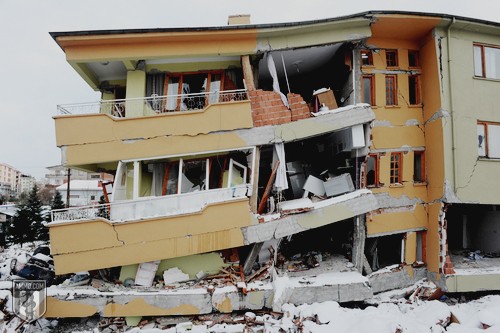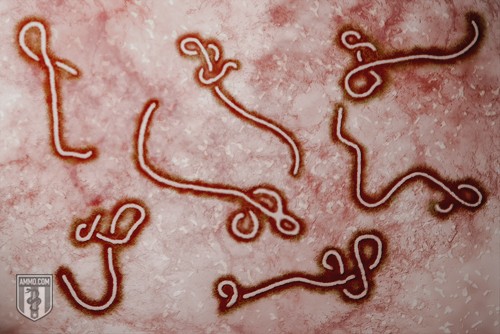How to Survive a Terrorist Attack: Prepare, Plan, and Survive
You're free to republish or share any of our articles (either in part or in full), which are licensed under a Creative Commons Attribution 4.0 International License. Our only requirement is that you give Ammo.com appropriate credit by linking to the original article. Spread the word; knowledge is power!
 Terrorism preparedness may be the least attractive subject you can think of, but preparing for the worst is an important part of keeping your family safe. Whether it’s an attack from abroad, or perhaps even scarier, an attack from within – terrorism is a very real threat.
Terrorism preparedness may be the least attractive subject you can think of, but preparing for the worst is an important part of keeping your family safe. Whether it’s an attack from abroad, or perhaps even scarier, an attack from within – terrorism is a very real threat.
Even after the devestating attacks of 9/11, many question whether our government has taken an effective approach toward keeping our country safe. From increased drone usage to TSA’s “security theater” to our acceptance of refugees, many wonder if we are given only the appearance of safety.
And while the chances of you and your family being terror victims on U.S. soil are extraordinarily low, that doesn’t absolve you of your responsibility to stay prepared. Much like surviving a power outage or a food or water shortage, the only thing worse than such a disaster is not being prepared for one. This guide will make you more aware of potential attacks, how to survive if you become a victim, and how to prepare for the worst case scenarios.
Defining Terrorism
Terrorism is a violent attack, but with a specific aim: to influence politics, to inspire fear in the public, or to get the populace to doubt the legitimacy of their government or its ability to prevent terrorism.
The specific form of terrorism could be just about anything: bombings, mass shootings, assassinations, kidnappings, hijackings, cyber attacks, or even far more serious attacks involving nuclear, chemical and biological weapons. Who is likely to be a victim of terrorism? While no one person is at high risk, some places are more at risk to be targeted than others:
- Military bases
- Government facilities
- International airports
- Large cities
- Landmarks
- Sports stadiums
- Water supplies
- Food supplies
- Utility substations and interchanges
Furthermore, terrorism in the United States is broken down into two types:
Domestic Terrorism
These are home-grown groups that are not affiliated with international terrorist organizations. Examples of domestic terrorist groups include the Animal Liberation Front and Earth Liberation Front, the Black Liberation Army, New Left organizations like the Weathermen, the Symbionese Liberation Army and the May 19th Communist Organization and the Jewish Defense League.
International Terrorism
This is terrorism directed at the United States from forces originating outside of the country. The September 11th attacks were the deadliest international terrorist attacks on U.S. soil. Attacks with lower body counts directed, possibly directed or inspired by international terrorist organizations include the Pulse Nightclub shooting and the Fort Hood shooting – but the lines aren’t quite as sharp.
Terrorism in the United States: A Brief History
 Terrorism, both domestic and international, has a long and storied history in the United States. Whether it was dissident revolutionary groups who refused to pay taxes, radical elements of the labor movement, the New Left, or international groups operating in the United States like al-Qaeda or the PLO – there’s no shortage of groups to place blame for home-grown terrorism.
Terrorism, both domestic and international, has a long and storied history in the United States. Whether it was dissident revolutionary groups who refused to pay taxes, radical elements of the labor movement, the New Left, or international groups operating in the United States like al-Qaeda or the PLO – there’s no shortage of groups to place blame for home-grown terrorism.
Most terrorist attacks on the United States have not been orchestrated by large, sprawling organizations like one might expect. That’s because the FBI, BATF and other law enforcement agencies monitor these groups. Far more troubling and problematic are smaller, unknown groups who are lurking off of the government’s radar. For example, while the KKK has not committed a terrorist act in the United States since 1981, the Weathermen, a lesser-known leftist group, has a far more extensive rap sheet.
Two groups are in fierce competition for the most active terrorist causes in the United States: First, the militant wing of the anti-abortion movement has over 30 bombings, assassinations and other terrorist attacks under its belt. The other is Islamic extremism, which boasts a comparatively slight 21 attacks, albeit with a much more significant body count than anything else we’ve talked about.
How to Prepare for a Terrorist Attack
There are some general precautions everyone should take to prevent themselves from becoming a victim of terrorism. These include:
- Situational awareness – try to be aware of what is going on around you at all times. This is especially important when traveling in countries with higher incidences of terrorism than the United States.
- If you feel uncomfortable with a situation, leave. Don’t be paranoid, just be mindful.
- Never accept packages from strangers or allow your luggage to leave your control.
- If you notice any unusual behavior, always report it immediately to relevant security personnel.
- Any time you’re in a public place, make sure to briefly note the location of emergency exits. They’ll be a lot harder to find in the event of any incidents.
- For any possible scenario, emergency preparedness is key. Have cash on hand, emergency food and water supplies, and a decent cache of ammunition.
- If you live or work in a large building, talk to the owners about getting basic emergency supplies on every level of the building – including first-aid kits, hard hats, dust masks, portable radios with extra batteries, flashlights with extra batteries, and tape to mark off dangerous areas.
- Also consider talking to the owners about implementing a security program if they don't already have one. For example, adding walk-through metal detectors, cameras, and other items could help terrorism prevention as well as preparation.
These are the most basic precautions any of us can take against the possibility of a terrorist attack. But what can you do in the event of specific types of terrorist attacks?
Active Shooter Scenarios
This is the one at the forefront of a lot of people’s minds. In fairness, not all active shooter scenarios are terrorist attacks. But in the heat of the moment, such finer distinctions aren’t going to mean all that much to you. The typical active shooter situation lasts between 10 and 15 minutes, but law enforcement is going to arrive after that, so you’re basically on your own. Basic survival tips for an active shooter situation include:
- Situational awareness – have it and maintain it.
- Always know where the exits are.
- If you are in an office building, get out of the hallway, into an office and secure the door.
- Where safe and possible, try to take the shooter down yourself.
- In close quarters, your chances of survival are significantly greater if you try to incapacitate the shooter.
- Whenever safe, call 911 yourself.
There are three things you can do in an active shooter scenario to stay alive:
Run
- Get an escape route and follow it.
- Leave, even if others will not.
- Leave your belongings behind.
- Prevent people from re-entering an area with an active shooter.
- Keep your hands visible when leaving.
- Cooperate with first responders on the scene.
- Don’t try to move the wounded.
- Call 911 when safe.
Hide
- Get out of the active shooter’s view.
- Provide protection for yourself and others if possible.
- Don’t trap yourself or restrict your options for movement.
- Lock the door and barricade it if possible.
- Silence your phone or pager.
- Stay behind large items and remain quiet.
- If you can, call 911. Even if you can’t speak, just leave the line open and let the dispatcher listen.
Fight
- As a last resort, fight with anything that you can grab.
- In many cases, producing a firearm of your own won’t result in a firefight – the shooter will run or turn the gun on himself.
When law enforcement arrives, follow all instructions, put down any items in your hands and raise your arms and spread your fingers. Avoid quick movements, screaming or pointing. Don’t ask them where to go, just go where they’re coming from. You will likely be held afterward for questioning. Do not leave until instructed to by law enforcement.
Terrorist Bombings: Explosive Terrorist Attacks
 Explosives are used in terrorist attacks frequently for one simple reason: they offer the most bang for buck, no pun intended. Explosive devices can be improvised from any number of commonly available materials, making them virtually untraceable. What’s more, you might get a bomb threat even if there’s no actual explosive.
Explosives are used in terrorist attacks frequently for one simple reason: they offer the most bang for buck, no pun intended. Explosive devices can be improvised from any number of commonly available materials, making them virtually untraceable. What’s more, you might get a bomb threat even if there’s no actual explosive.
In the event that someone calls in a bomb threat, try to gather as much information as possible. Ask the following questions:
- When is the bomb set to go off?
- Where is it?
- What does it look like?
- What kind of bomb is it?
- How will it explode?
- Did you place the bomb?
- Why?
- What is your address?
- What is your name?
You want to keep the caller on the line for as long as possible. Make a record of as much information as you can, then call the police and building management.
In the event of an explosion, getting under a desk is the best course of action as these protect you from falling debris. When it’s safe, exit as quickly as possible. Do not take your belongings and do not use the elevator. Once you make it out of the building, stay away from the windows, as they might turn into shattered glass. Also stay away from the streets and sidewalks so that first responders can get in to provide help.
If you find yourself trapped in debris, here are some steps to stay safe:
- Cover your face with a dust mask if possible, a bandana if not.
- Use a flashlight to signal to rescuers if possible, or even a whistle.
- Shout as a last resort, as it can cause you to inhale dust.
Not all bombs are going to come in the form of a bomb threat. Many come in suspicious packages. The marks of suspicious packages include:
- Unexpected packages from people not familiar to you.
- No return address or strange, unverifiable return addresses.
- Anything with protruding wires, metal (including foil), strange odors, leaks or stains.
- Shows an address that doesn’t match the postmark.
- Excessive postage or packing material.
- Not addressed to a specific person.
- Outdated addresses, such as packaged to people who no longer work for the company.
- Misspellings of common words.
Chemical Terrorism and Biological Attacks
 The 2001 anthrax attacks show that there can also be attacks with chemical and biological agents. In fact, this can be a very effective way of creating terror, as the biological agent doesn’t have to actually be toxic, but can merely be perceived to be toxic.
The 2001 anthrax attacks show that there can also be attacks with chemical and biological agents. In fact, this can be a very effective way of creating terror, as the biological agent doesn’t have to actually be toxic, but can merely be perceived to be toxic.
While chemical and biological attacks are different, they’re also very similar: invisible or barely visible chemicals or organisms are going to make you sick or kill you.
First, let’s talk about chemical attacks. There are six basic types of chemical attacks terrorists might attempt:
- Agents like phosphene that attack the lungs
- Cyanide
- Blistering gases like mustard gas, known as vesicants
- Nerve agents like GA (tabun), GB (sarin), GD (soman), GF, and VX
- Incapacitating agents like BZ
- Riot-control agents like MACE
Then there are biological agents likely to be used in an attack:
- Bacteria: Organisms that can be treated with antibiotics. They replicate on their own.
- Viruses: Diseases whose symptoms can be treated. Needs a host to replicate.
- Toxins: Poisons extracted from other living creatures.
Biological agents differ from chemical agents because the former is much more difficult to deliver. The main delivery systems for biological agents include:
- Aerosols: This is when the agent is released into the air. Fortunately for you, this actually doesn’t work for a lot of biological agents.
- Animals: Infecting fleas, lice, rats and livestock, then letting them loose, can have a devastating effect on a population.
- Food and Water: This is one you should be worried about – but only because you have the most control here. Food can be cooked and water can be boiled, eliminating most pathogens.
Preparing for a biological or chemical attack can be tricky to say the least. So what can you do to get ready for something that’s so vague and diffuse? This is the main reason you should have a very basic disaster supply kit, which should include:
- Battery-powered radio and flashlight with plenty of extra batteries
- A first-aid kit
- A sanitation kit, including soap and bleach
- Plastic for the windows and doors in case you need to shelter in place
- Food and drinking water
- Duct tape and scissors
If you find yourself in the middle of a biological or chemical attack, here’s how to stay safe:
- First and foremost, listen to and follow the instructions of authority figures on how to stay safe. The situation will be rapidly changing and information will be conflicting, so follow all orders of safety officials.
- If you’re sheltering in place, a few tips to remain safe include:
- Turn off all the ventilation, vents and air conditioning.
- Shelter down in an internal room, the fewer windows the better.
- Seal the room with duct tape and plastic
- Everyone in the room needs ten square feet of floor space for five hours of air.
- Remain in the protected area until the vapors are gone.
- When in open country:
- Get up-wind.
- Find shelter.
- Listen to the radio for further instructions.
In the event of a chemical attack:
- Be careful helping others, as you might expose yourself to further contamination.
- Remove clothes, avoiding the eyes, nose and mouth. Cut them off if you can.
- Wash your hands with soap and water.
- Remove your glasses or contact lenses. Eyeglasses should be soaked in bleach.
- Flush your eyes with lots of water.
- Put any contaminated items into a plastic bag and dispose of them.
- Wash your face with soap and water.
- Blot contaminated areas of your body with a clean, soapy towel. Do not wipe.
- Where possible, proceed to a medical facility.
The problem with a biological attack is that you might not know you’ve been a victim for some time. Pay attention to official reports. Don’t be paranoid, but do seek medical attention if you believe you’ve become infected.
Nuclear Attacks
 Here’s the really exciting one: nuclear attacks. Gone are the days when a nuclear attack was going to come from a state actor. The chances are far greater that the next atomic attack will come from a terrorist attack. When we speak of a “nuclear attack,” we’re talking about two different things:
Here’s the really exciting one: nuclear attacks. Gone are the days when a nuclear attack was going to come from a state actor. The chances are far greater that the next atomic attack will come from a terrorist attack. When we speak of a “nuclear attack,” we’re talking about two different things:
Radiological Dispersion Device
This is the “dirty bomb.” It’s not actually a nuclear explosion, but rather a conventional explosive seeking to disperse radiation over a broader area. The impact of such an attack is largely psychological – while a dirty bomb won’t actually kill or make many people sick, it will make them afraid as well as tax local health and disaster relief resources.
Improvised Nuclear Device
The IND is what you should really be worried about. It’s the archetypal “suitcase nuke” – a fully functioning nuclear fission device concealed in a suitcase. Something the size of what the U.S. dropped on Hiroshima is not outside the realm of possibility for non-state actors to acquire and deploy. What’s more, when deployed from the ground rather than the air, the consequences are far more destructive. This is considered a present danger in Europe.
The dangers of the latter include nuclear fallout and a loss of the power grid, in addition to the actual blast. Preparing for a nuclear blast is close to impossible without large-scale disaster preparedness, but here’s some basic situational preparedness you can do:
- Find nearby designated fallout shelters. Believe it or not, there are a ton of these left over from the Cold War.
- Better yet, find out where the blast shelters are so that you can run to one of those in the event of an attack.
- Don’t look at the fireball, it can blind you.
- Find shelter where possible. If this is not possible, lay on the ground in the prone position and cover your head. It takes up to 30 seconds or more for the blast to hit where you are.
- In all cases, continue to tune into your local emergency radio for status updates and instructions.
Remember that while you don’t want to be too paranoid, you do want to prepare for the worst (and hope for the best). Even if you see a major terrorist attack in your lifetime, the chances of you being personally impacted by this are very, very low. However, by spending just a little time on preparing for terrorist attacks, you can dramatically improve you and your family’s chances of survival.
Preparedness
- Natural Disaster Survival Guide: Your Emergency Checklist
- Emergency Food Supply And Storage: The Survival Guide
- How to Prepare For Flooding: A Guide to Flood Survival
- How to Prepare for a Hurricane: A Survival Guide for Tropical Disasters
- Wildfire Safety Tips: The Ultimate Guide to Heatwave Safety and Preparedness
- Earthquake Survival Guide: How to Prepare for and Survive an Earthquake
- How to Survive a Tsunami: An Expert Tsunami Survival Guide
- How to Survive If the Power Grid Goes Down: Power Grid Failure Preparedness Guide
- How to Prepare for a Tornado: The Definitive Safety Guide
- How to Survive a Terrorist Attack: Prepare, Plan, and Survive
- Living off the Grid? These 8 Essential Off Grid Living Tips Will Help
- Surviving in the Outdoors: An Emergency Guide
- Ammo Storage: How to Store Ammo and Transport it Safely
- Top 27 Online Resources for Survivalists and Preppers
- Cold Weather Preparedness: A Guide to Winter Weather Survival
- Wildcat Cartridges: A Guide to Wildcatting and Customized Rounds
- Get Paid $1,200 to Watch the 12 Best Prepper Movies as You Self-Quarantine to Avoid COVID-19
